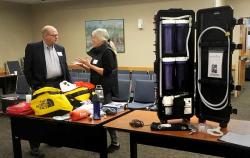- District
-
Schools
-
Welcome to our schools
-
Find Your School
School Boundaries
ELEMENTARY
Antonia Crater Elementary Dundee Elementary Edwards Elementary Ewing Young Elementary Joan Austin Elementary Mabel Rush Elementary -
SECONDARY
Chehalem Valley Middle School Mountain View Middle School Newberg High School CatalystVIRTUAL
COA Virtual Program
-
Find Your School
School Boundaries
-
-
Academics
-
Learning for the 21st Century
-
-
Parents/Students
-
Connecting School and Home
- Attendance and Grade Info Bus Transportation Childcare Community Resources Complaint Process Counseling Services School Start and End Times Delays / Closures E-Friday Folder Enroll / Transfer
- Federal Notifications Get Involved Health Services Learning Resources Menus ParentVUE Student Records Student Safety/Report a Tip Student Code of Conduct Volunteer
-
- Staff
In The News: City, faith groups prep for a disaster
Written by: Colin Staub
Contingent of leaders from churches, local governments discuss emergency preparedness
With the growing sense that the Cascadia Subduction Zone will produce a major earthquake in the Pacific Northwest during the next half-century, the city of Newberg wants to take stock of how prepared its citizens and institutions are to weather a large scale disaster.
Last week City Manager Joe Hann
an brought together a group of nearly 50 individuals representing churches, city government, law enforcement and other entities to discuss preparing for an emergency.
One way the city is getting ready for a catastrophic event is through its stockpile of 14 water treatment systems known as “Hurricane” Portable Water Purification Machines. The machines use what’s called a “ceramic silver impregnated” filter that removes nearly all biological contaminants from the water that runs through it.
Last month the City Council received a presentation from a maker of the machines as well as public works maintenance superintendent Russ Thomas. They mixed up some muddy water using dirt from the baseball infield at George Fox University and ran it through the machine, producing clear and drinkable water.
“We would like to strategically place them in churches so that if things happen, all the buildings come down, (so) we can provide water to our residents,” Hannan said.
In Newberg, churches are particularly well-suited to be safe shelter areas during an emergency, due to their abundance around town. Emergency planners want to avoid directing a huge crowd to the same place during a disaster; with at least one church located within most Newberg neighborhoods, the thinking is they could be turned into neighborhood emergency shelters.
Sheriff Tim Svenson talked about the CERT (Community Emergency Response Teams) program, a federal program that trains individuals in disaster response through CERT classes around the country. Nearby CERT training programs are provided by Yamhill County as well as the city of McMinnville.
“There’s always this thought from the community that when there’s a major event government’s going to come in and bail them out,” Svenson said. But that’s not necessarily the case. Governments prepare for the high-level policy decisions and how to bring government operations back up in the event of an emergency; but local residents will likely be on their own for some period of time.
“We need people to be able to support themselves … for at least a week,” Svenson said. That means collaboration between CERT-trained groups, faith-based organizations, community leaders and other entities to ensure people can subsist on a local level until governments can come in and assist.
One local example of a well-prepared group is the Ladd Hill neighborhood, which has about 30 people who are CERT trained. Hannan described it as “pretty mind-boggling how well-organized and oiled the machine is.”
Stan Halle, a neighborhood representative, described the evolution of its CERT team, which began nearly six years ago as a neighborhood watch program. It has grown more organized to the point where it covers about 33 square miles in the south Parrett Mountain area. Planning discussions cover everything from minimizing casualties to caring for livestock during a disaster.
“Our vision is to make us safe, less vulnerable and better able to cope,” Halle said.
For more information on the CERT program, visit http://yccert.org/. For extensive information on emergency preparedness in general, visit the South Parrett Mountain Emergency Plan website at www.spm-ep.org.
Kym Leblanc-Esparza, superintendent of the Newberg School District, described the challenges the school district would face in a catastrophe.
She brought up the schools’ obligation of “in loco parentis,” which is the legal responsibility the district takes to assume parental status for children during school hours.
“If (a disaster) occurs anytime between about 6:30 in the morning and 4:00 in the afternoon, we have 5,000 children that are now ours,” she said.
That means some children may need to live in the school buildings if they are cut off from their families — a possibility given the number of bridges in the area and the number of people that commute in and out of the area each day. Leblanc-Esparza described the partnership between all the agencies at the meeting as “absolutely essential, so that we can provide all that’s going to be necessary in this kind of magnitude of emergency.”
Mayor Bob Andrews said he plans to host more such sessions in the future to see where the group wants to go from here. He posed the question of whether there is interest in convening an “emergency council” that would consist of representatives of the city, faith-based community, county and others.
After all, as Svenson noted to the crowd, “In our county, it’s not a matter of if, it’s a matter of when something’s going to happen. And we are truly going to have to be able to stand alone and take care of ourselves for at least a week until the state can come in and help.”

